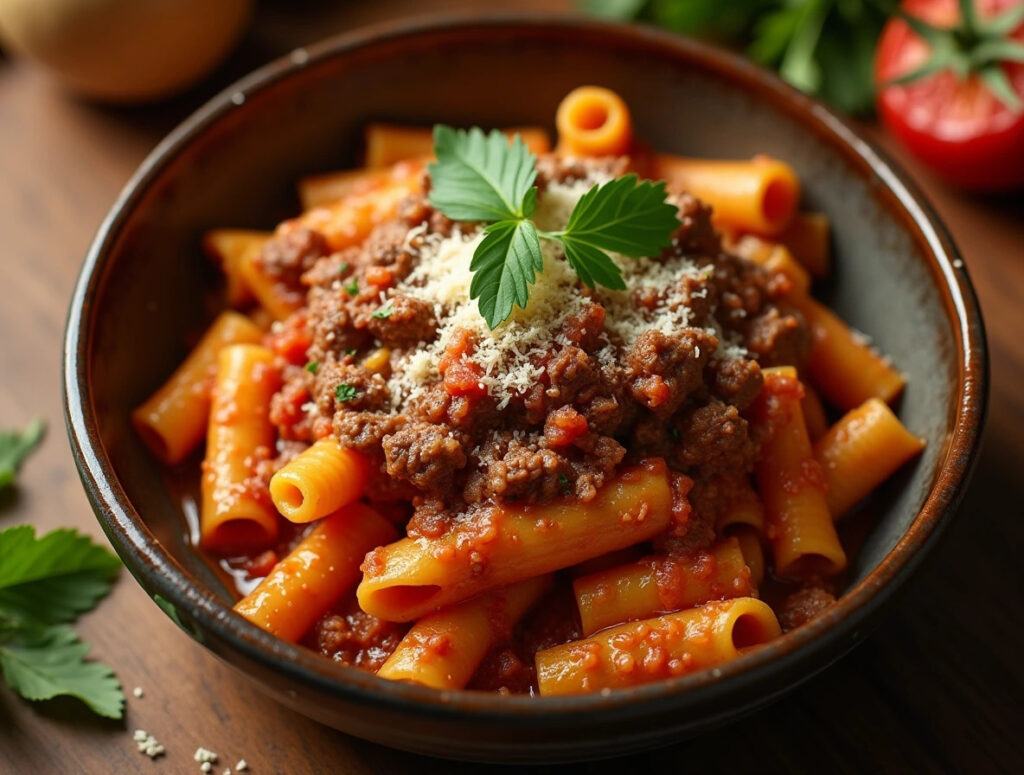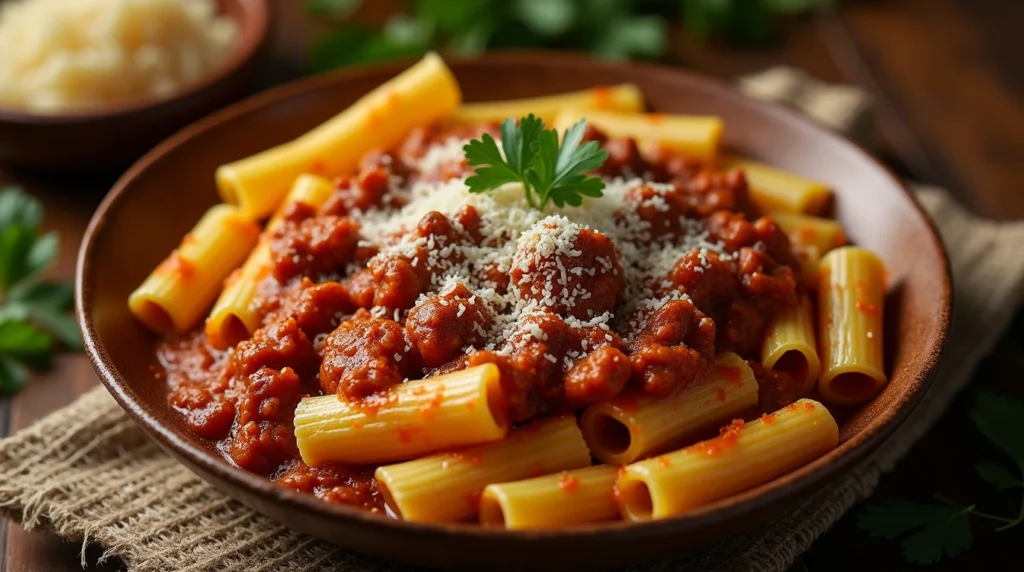- Introduction:
- A Taste of Tradition: Why This Dish Matters
- What is Rigatoni alla Grassa?
- Ingredients for Authentic Rigatoni alla Grassa
- How to Make Rigatoni alla Grassa (Step-by-Step)
- Expert Tips for the Perfect Rigatoni alla Grassa Recipe
- Historical Roots: A Dish Born in Bologna’s Kitchens
- What to Serve with Rigatoni alla Grassa
- Conclusion – A Bowl of Bologna’s Heart
- FAQ – Rigatoni alla Grassa Recipe
Rigatoni alla Grassa Recipe
Introduction:
If you’ve ever dreamed of sitting at a rustic wooden table in a warm Italian kitchen while the scent of slow-simmered meat sauce drifts through the air—this dish is your invitation. Though not as widely recognized as other Bolognese classics, Rigatoni alla Grassa holds a special charm—blending rustic simplicity with rich, soulful flavor in a way that defines authentic Italian comfort.
And lucky for you, mastering this recipe doesn’t require a ticket to Italy—just a few classic ingredients, a bit of time, and a whole lot of love.
A Taste of Tradition: Why This Dish Matters
You might already know Bologna as the birthplace of lasagna and tagliatelle al ragù, but rigatoni alla grassa holds a special place at the heart of Emilian cuisine. You’re not just following a recipe here—you’re serving up a story, one that’s been told through generations and captured in every bite. Whether you’re making it for a cozy family dinner or a weekend indulgence, it offers more than just nourishment—it gives you a piece of culinary history passed down through generations.
What sets it apart is its “grassa” (literally “fat” or “rich”) character. That richness isn’t just about the ingredients—it’s about slow cooking, big flavor, and generous hospitality. And that’s exactly what you’re about to bring into your own kitchen.
What is Rigatoni alla Grassa?
A Regional Gem from Emilia-Romagna
Rigatoni alla grassa is a deeply savory pasta dish known for its meaty sauce, creamy finish, and bold flavor. While it shares similarities with Bolognese ragù, it’s a little more indulgent and slightly simpler, often made without heavy tomato sauces and layered instead with the natural richness of pancetta, pork, beef, and whole milk.
What you get is a glossy, full-bodied sauce that clings to every groove of rigatoni pasta, ensuring every bite is loaded with flavor. If you’re a fan of slow-cooked, deeply comforting food, this one deserves a permanent place in your rotation.
Ingredients for Authentic Rigatoni alla Grassa
To bring this dish to life, it’s essential to stick with high-quality, traditional ingredients. Think fresh, fatty cuts of meat and the best pasta you can find.
Traditional Ingredients Table
| Ingredient | Quantity | Notes |
|---|---|---|
| Rigatoni pasta | 400g | Bronze-cut for best sauce absorption |
| Ground pork | 250g | Use fatty cuts |
| Ground beef | 250g | 80/20 lean-to-fat ratio |
| Pancetta | 100g | Finely diced |
| Onion | 1 large | Finely chopped |
| Celery | 1 stalk | Finely chopped |
| Carrot | 1 medium | Finely chopped |
| Tomato paste | 2 tbsp | Adds depth and color |
| Whole milk | 150ml | Balances the richness |
| Dry white wine | 100ml | De-glazes the pan |
| Parmigiano Reggiano | To serve | Freshly grated only |
| Olive oil or lard | As needed | For sautéing; lard is more traditional |
| Salt & Pepper | To taste | Adjust throughout cooking |
Ingredient Tips:
- Always opt for fresh pancetta over cured bacon—it’s less smoky and more authentic.
- Use whole milk, not low-fat or cream substitutes, to achieve that classic silkiness.
- Don’t skip the soffritto—that trio of onion, carrot, and celery forms the flavor base.

How to Make Rigatoni alla Grassa (Step-by-Step)
Cooking the Sauce – The Heart of the Dish
This sauce isn’t about shortcuts. It’s about depth, patience, and coaxing out the very best from each ingredient. Set aside at least 90 minutes to do it right—you won’t regret it.
- Sauté the Soffritto: In a large pot or Dutch oven, heat olive oil or lard. Add the chopped onion, celery, and carrot. Let it sizzle over medium heat until the vegetables turn tender and release a rich, inviting aroma—this usually takes about 8 to 10 minutes.
- Add Pancetta: Toss in the pancetta and cook until it renders and starts to crisp slightly.
- Brown the Meats: Add the ground pork and beef. Break them up with a spoon and let them brown fully. Don’t rush this—color means flavor.
- Deglaze with Wine: Pour in the white wine, scraping the bottom of the pan to lift all that goodness.
- Tomato Paste Time: Stir in the tomato paste and cook for 2–3 minutes to mellow the acidity.
- Pour in the Milk: Let the sauce come together, then reduce the heat to low. Season with salt and pepper.
- Simmer Slowly: Let it bubble gently for at least 1 hour. Give it a gentle stir every now and then to keep the flavors moving, and sneak a small spoonful once in a while to track the richness building.
Boiling the Pasta
- Use a large pot of well-salted water.
- Cook rigatoni until al dente (usually a minute or two less than package directions).
- Reserve half a cup of pasta water before draining—it might come in handy for loosening the sauce.
Bringing It All Together
- When the rigatoni reaches that perfect bite, transfer it straight into the pot of simmering sauce, ready to soak up all the flavor. Keep the flame low and fold everything together slowly, giving the rigatoni time to soak up every bit of flavor without rushing.
- If the mixture feels a bit heavy or tight, a small pour of the water you saved from boiling the pasta can help loosen it to the perfect texture.
- Serve immediately with a generous sprinkle of Parmigiano Reggiano.
Expert Tips for the Perfect Rigatoni alla Grassa Recipe
If you want your rigatoni alla grassa to taste like it came from a Bolognese grandmother’s kitchen, here are some tried-and-true tips:
- Use a heavy-bottomed pan to avoid burning the base during long simmering.
- Let the sauce rest: After simmering, give it 10–15 minutes to sit with the heat off—it deepens the flavor.
- Grate the cheese fresh. Pre-grated cheese is often coated in anti-caking agents that mess with texture.
- Don’t overcook the pasta! It should have a slight chew to stand up to the richness of the sauce.
Historical Roots: A Dish Born in Bologna’s Kitchens
Nicknamed La Grassa, or “The Fat One,” Bologna wears its culinary reputation with pride. Nestled in Emilia-Romagna, it’s a place where food isn’t just sustenance—it’s a generous celebration of abundance, bold flavor, and heartfelt tradition.
Unlike the more tomato-forward sauces found in the south of Italy, northern cuisine leans into meat, dairy, and slow cooking. Rigatoni alla grassa evolved from centuries of farm-to-table traditions, where families made use of every part of the animal and prioritized big, bold flavor.
This isn’t just cooking—it’s reviving tradition and sharing it at your table. You’re keeping a tradition alive, one flavorful bite at a time.
“In Bologna, food is not just nourishment—it’s storytelling.”
What to Serve with Rigatoni alla Grassa
This dish stands strong on its own, but you can take it up a notch with a few carefully chosen sides:
Pairings:
- Starter: A crisp arugula salad topped with shaved Parmigiano and a zesty lemon vinaigrette.
- Wine: Dry red wines like Sangiovese, Chianti, or even sparkling Lambrusco.
- Side: Rustic Italian bread or grilled seasonal vegetables.
- Dessert: Something simple like panna cotta or dark chocolate with espresso.

Conclusion – A Bowl of Bologna’s Heart
You don’t need to be Italian—or even a seasoned cook—to master this dish. All you need is a little patience, a few quality ingredients, and the willingness to let flavors unfold the way they were meant to: slowly, lovingly, and unapologetically rich.
Rigatoni alla grassa isn’t just a recipe. It’s an experience. And now, it’s yours to share.
FAQ – Rigatoni alla Grassa Recipe
Can I use other pasta shapes?
You can, but rigatoni is ideal because the ridges and hollow center trap the sauce perfectly. Penne is a decent alternative, but avoid smooth pasta like spaghetti.
Can I prepare rigatoni alla grassa in advance?
In fact, it’s even more flavorful the next day. Simply store it in an airtight container and reheat with a bit of water or broth.
Is rigatoni alla grassa similar to Bolognese?
It’s in the same family but more focused on meat and dairy rather than a heavily tomato-based sauce. Think of it as the creamier, bolder cousin of traditional Bolognese.
Can I freeze the sauce?
Definitely. Just freeze the sauce alone (without pasta) in an airtight container. It’ll keep for up to 3 months. Let it thaw in the fridge overnight, then warm it gently on the stove.
💬 Call to Action:
Tried this rigatoni alla grassa recipe? Let us know how it turned out! Drop a comment below, share a photo on social media, or tag a fellow pasta lover who needs this in their life. And don’t forget to subscribe for more authentic Italian recipes straight from the heart of the kitchen.
